Page 347 of 566
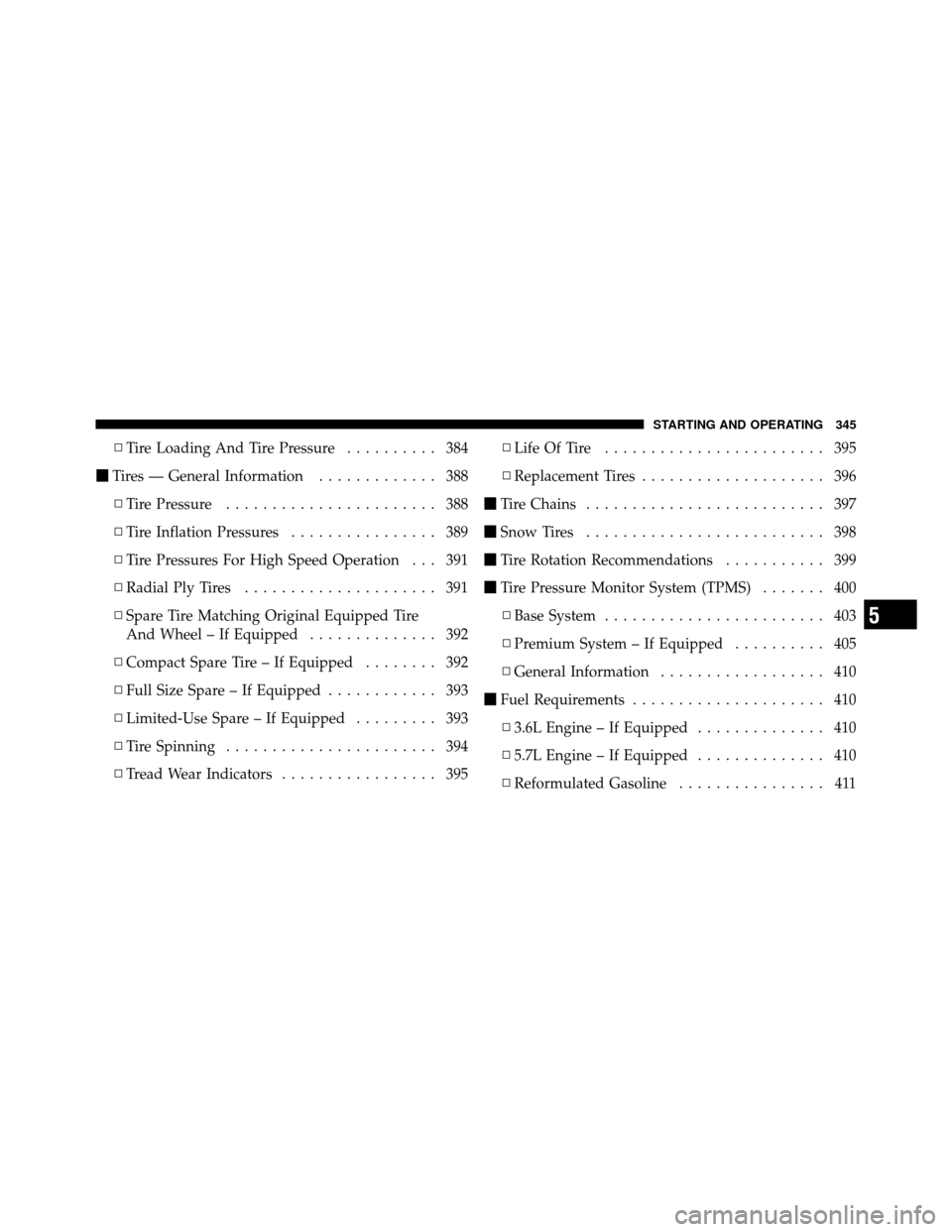
▫Tire Loading And Tire Pressure .......... 384
� Tires — General Information ............. 388
▫ Tire Pressure ....................... 388
▫ Tire Inflation Pressures ................ 389
▫ Tire Pressures For High Speed Operation . . . 391
▫ Radial Ply Tires ..................... 391
▫ Spare Tire Matching Original Equipped Tire
And Wheel – If Equipped .............. 392
▫ Compact Spare Tire – If Equipped ........ 392
▫ Full Size Spare – If Equipped ............ 393
▫ Limited-Use Spare – If Equipped ......... 393
▫ Tire Spinning ....................... 394
▫ Tread Wear Indicators ................. 395 ▫
Life Of Tire ........................ 395
▫ Replacement Tires .................... 396
� Tire Chains .......................... 397
� Snow Tires .......................... 398
� Tire Rotation Recommendations ........... 399
� Tire Pressure Monitor System (TPMS) ....... 400
▫ Base System ........................ 403
▫ Premium System – If Equipped .......... 405
▫ General Information .................. 410
� Fuel Requirements ..................... 410
▫ 3.6L Engine – If Equipped .............. 410
▫ 5.7L Engine – If Equipped .............. 410
▫ Reformulated Gasoline ................ 411
5
STARTING AND OPERATING 345
Page 348 of 566
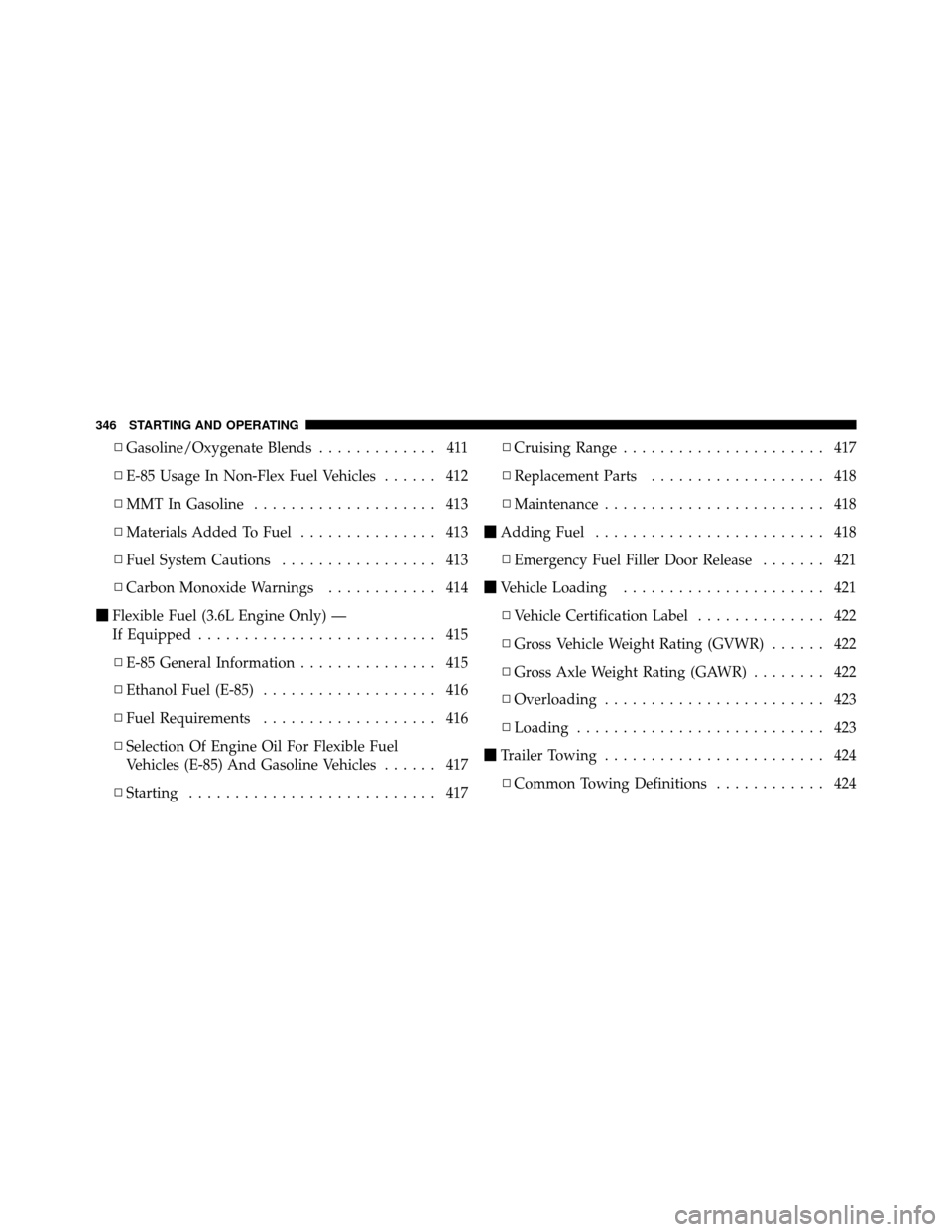
▫Gasoline/Oxygenate Blends ............. 411
▫ E-85 Usage In Non-Flex Fuel Vehicles ...... 412
▫ MMT In Gasoline .................... 413
▫ Materials Added To Fuel ............... 413
▫ Fuel System Cautions ................. 413
▫ Carbon Monoxide Warnings ............ 414
� Flexible Fuel (3.6L Engine Only) —
If Equipped .......................... 415
▫ E-85 General Information ............... 415
▫ Ethanol Fuel (E-85) ................... 416
▫ Fuel Requirements ................... 416
▫ Selection Of Engine Oil For Flexible Fuel
Vehicles (E-85) And Gasoline Vehicles ...... 417
▫ Starting ........................... 417 ▫
Cruising Range ...................... 417
▫ Replacement Parts ................... 418
▫ Maintenance ........................ 418
� Adding Fuel ......................... 418
▫ Emergency Fuel Filler Door Release ....... 421
� Vehicle Loading ...................... 421
▫ Vehicle Certification Label .............. 422
▫ Gross Vehicle Weight Rating (GVWR) ...... 422
▫ Gross Axle Weight Rating (GAWR) ........ 422
▫ Overloading ........................ 423
▫ Loading ........................... 423
� Trailer Towing ........................ 424
▫ Common Towing Definitions ............ 424
346 STARTING AND OPERATING
Page 353 of 566
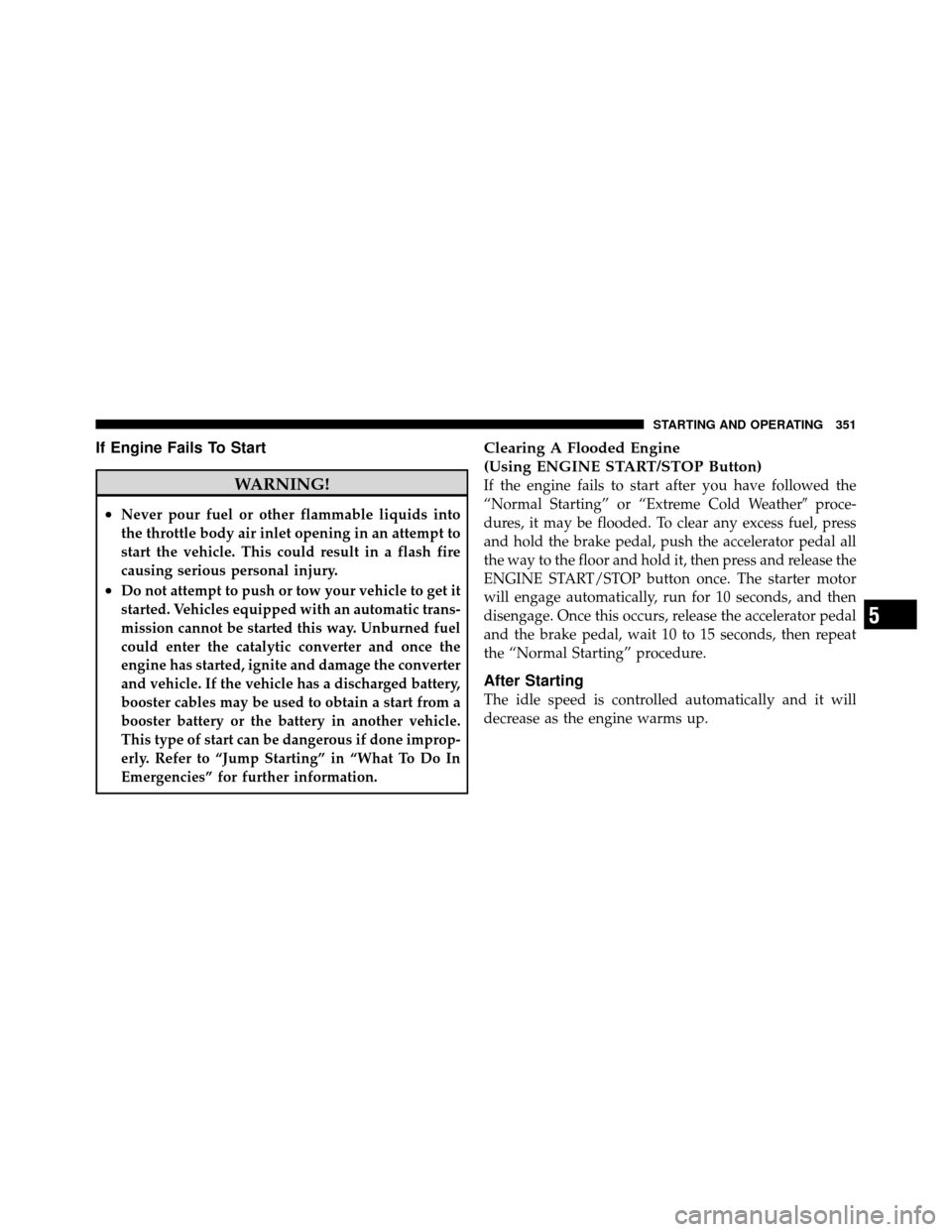
If Engine Fails To Start
WARNING!
•Never pour fuel or other flammable liquids into
the throttle body air inlet opening in an attempt to
start the vehicle. This could result in a flash fire
causing serious personal injury.
•Do not attempt to push or tow your vehicle to get it
started. Vehicles equipped with an automatic trans-
mission cannot be started this way. Unburned fuel
could enter the catalytic converter and once the
engine has started, ignite and damage the converter
and vehicle. If the vehicle has a discharged battery,
booster cables may be used to obtain a start from a
booster battery or the battery in another vehicle.
This type of start can be dangerous if done improp-
erly. Refer to “Jump Starting” in “What To Do In
Emergencies” for further information.
Clearing A Flooded Engine
(Using ENGINE START/STOP Button)
If the engine fails to start after you have followed the
“Normal Starting” or “Extreme Cold Weather�proce-
dures, it may be flooded. To clear any excess fuel, press
and hold the brake pedal, push the accelerator pedal all
the way to the floor and hold it, then press and release the
ENGINE START/STOP button once. The starter motor
will engage automatically, run for 10 seconds, and then
disengage. Once this occurs, release the accelerator pedal
and the brake pedal, wait 10 to 15 seconds, then repeat
the “Normal Starting” procedure.
After Starting
The idle speed is controlled automatically and it will
decrease as the engine warms up.
5
STARTING AND OPERATING 351
Page 359 of 566
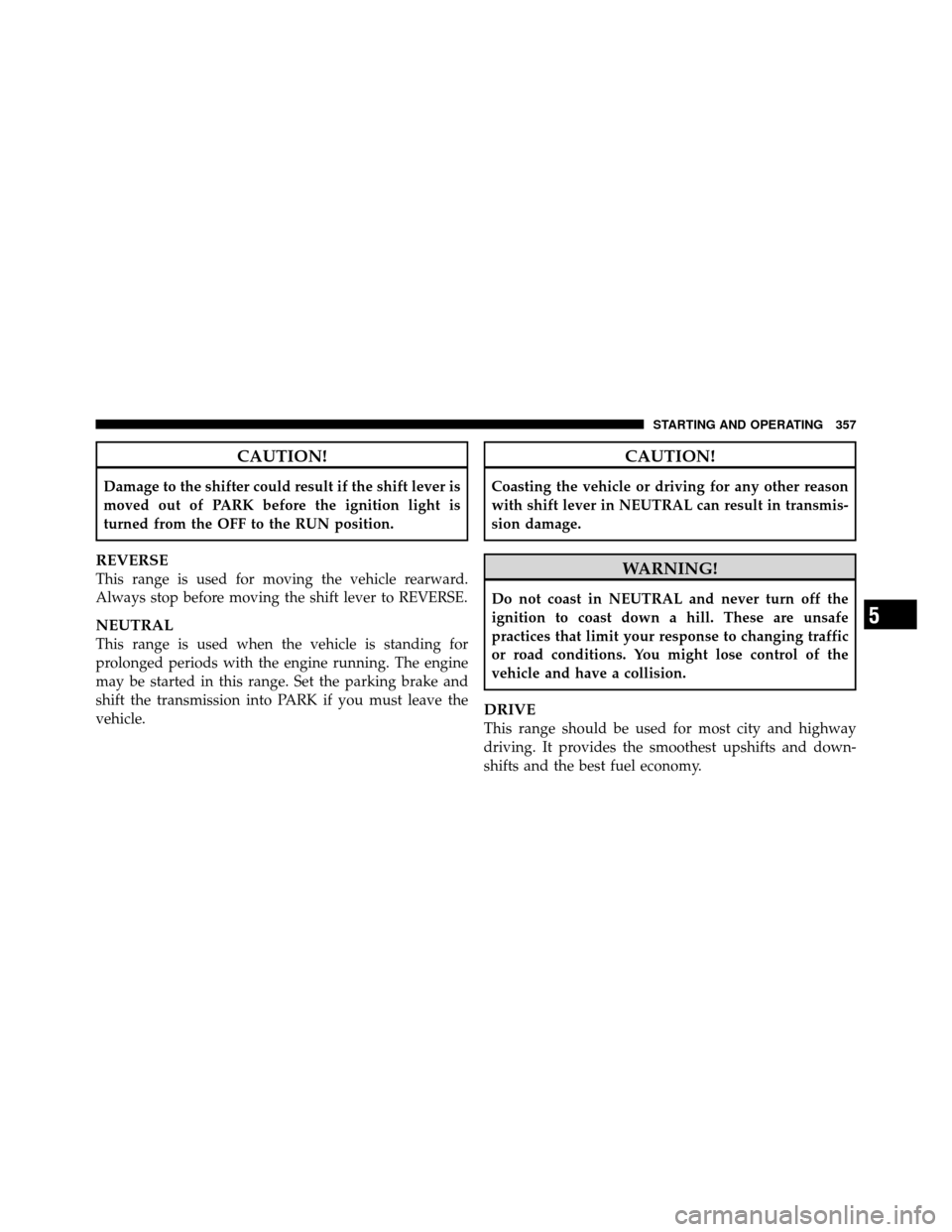
CAUTION!
Damage to the shifter could result if the shift lever is
moved out of PARK before the ignition light is
turned from the OFF to the RUN position.
REVERSE
This range is used for moving the vehicle rearward.
Always stop before moving the shift lever to REVERSE.
NEUTRAL
This range is used when the vehicle is standing for
prolonged periods with the engine running. The engine
may be started in this range. Set the parking brake and
shift the transmission into PARK if you must leave the
vehicle.
CAUTION!
Coasting the vehicle or driving for any other reason
with shift lever in NEUTRAL can result in transmis-
sion damage.
WARNING!
Do not coast in NEUTRAL and never turn off the
ignition to coast down a hill. These are unsafe
practices that limit your response to changing traffic
or road conditions. You might lose control of the
vehicle and have a collision.
DRIVE
This range should be used for most city and highway
driving. It provides the smoothest upshifts and down-
shifts and the best fuel economy.
5
STARTING AND OPERATING 357
Page 362 of 566
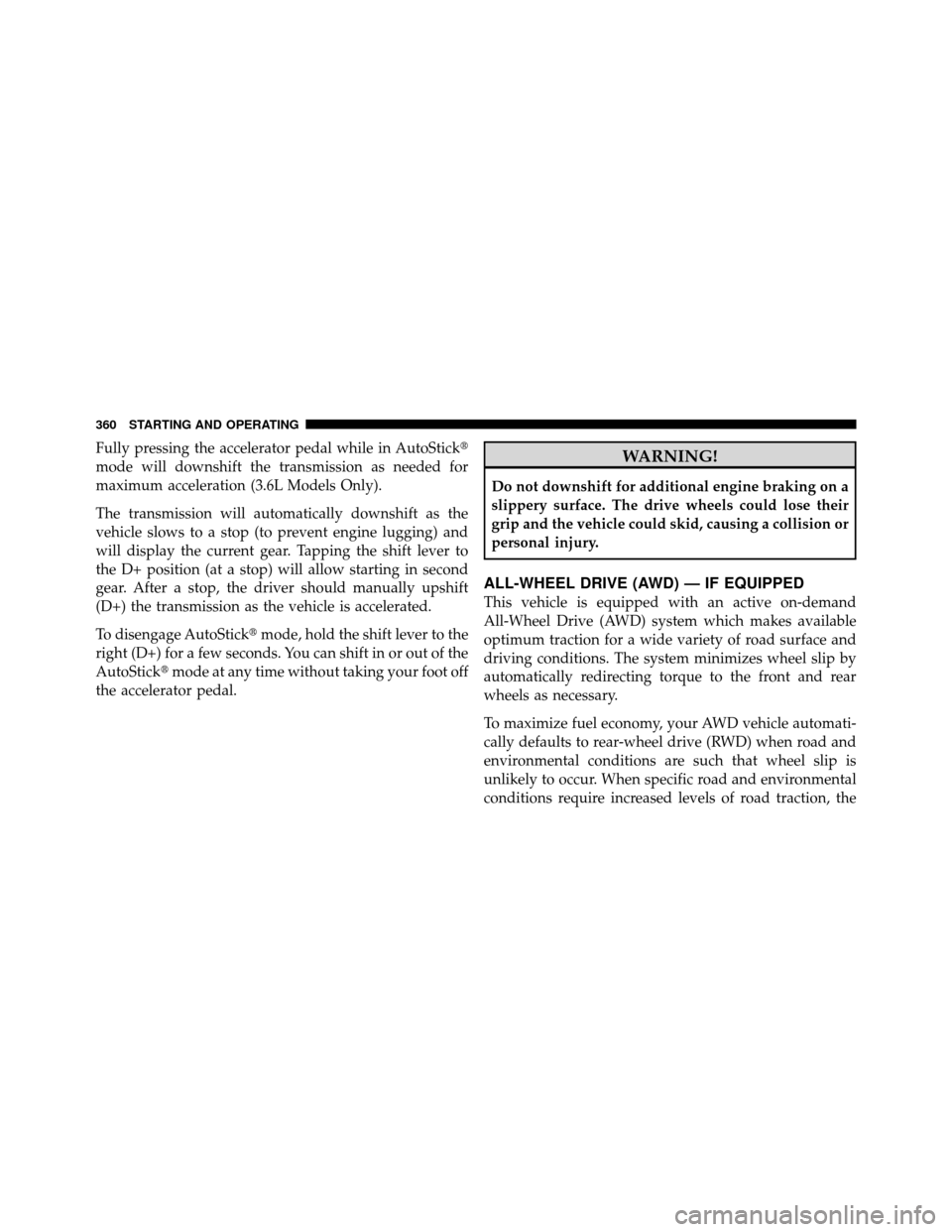
Fully pressing the accelerator pedal while in AutoStick�
mode will downshift the transmission as needed for
maximum acceleration (3.6L Models Only).
The transmission will automatically downshift as the
vehicle slows to a stop (to prevent engine lugging) and
will display the current gear. Tapping the shift lever to
the D+ position (at a stop) will allow starting in second
gear. After a stop, the driver should manually upshift
(D+) the transmission as the vehicle is accelerated.
To disengage AutoStick�mode, hold the shift lever to the
right (D+) for a few seconds. You can shift in or out of the
AutoStick� mode at any time without taking your foot off
the accelerator pedal.WARNING!
Do not downshift for additional engine braking on a
slippery surface. The drive wheels could lose their
grip and the vehicle could skid, causing a collision or
personal injury.
ALL-WHEEL DRIVE (AWD) — IF EQUIPPED
This vehicle is equipped with an active on-demand
All-Wheel Drive (AWD) system which makes available
optimum traction for a wide variety of road surface and
driving conditions. The system minimizes wheel slip by
automatically redirecting torque to the front and rear
wheels as necessary.
To maximize fuel economy, your AWD vehicle automati-
cally defaults to rear-wheel drive (RWD) when road and
environmental conditions are such that wheel slip is
unlikely to occur. When specific road and environmental
conditions require increased levels of road traction, the
360 STARTING AND OPERATING
Page 368 of 566
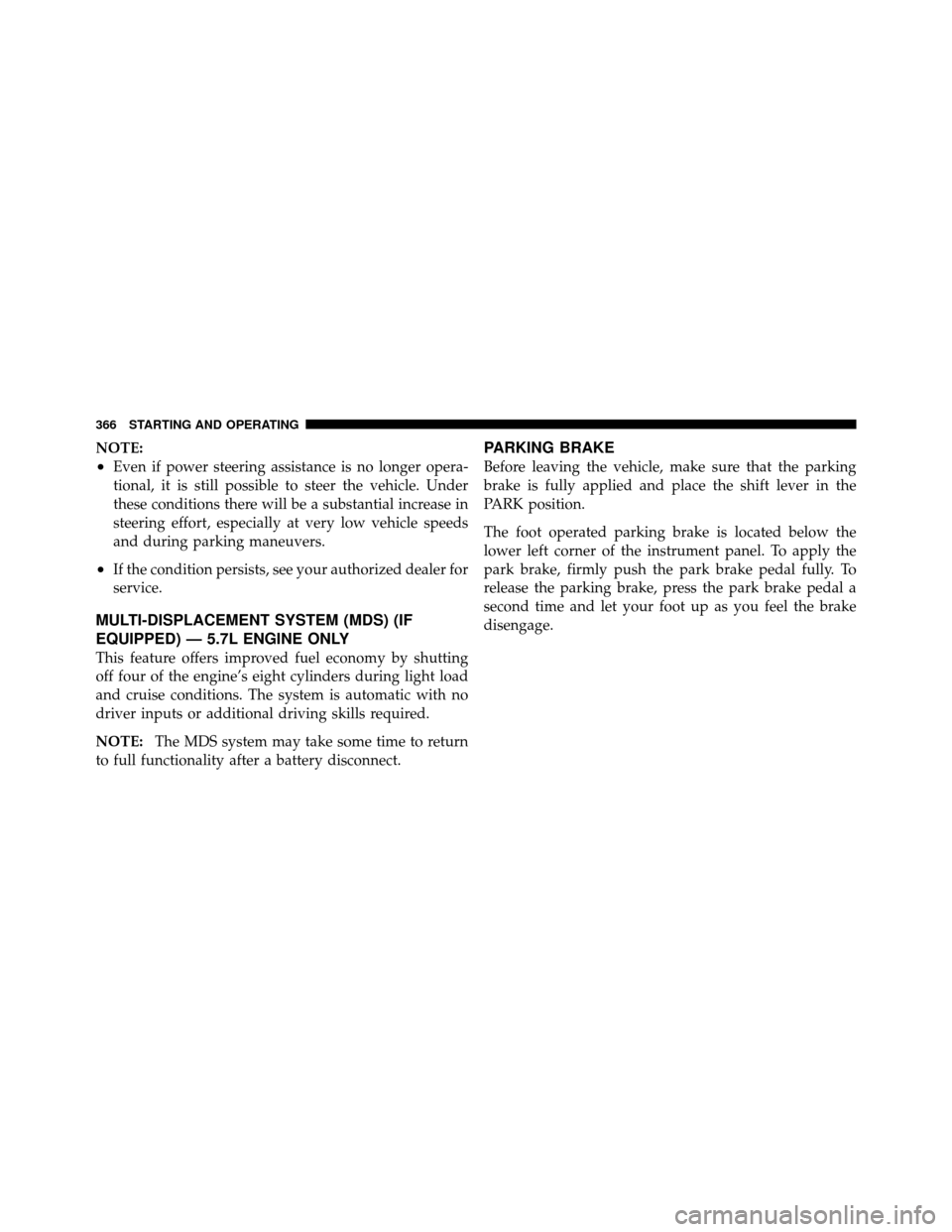
NOTE:
•Even if power steering assistance is no longer opera-
tional, it is still possible to steer the vehicle. Under
these conditions there will be a substantial increase in
steering effort, especially at very low vehicle speeds
and during parking maneuvers.
•If the condition persists, see your authorized dealer for
service.
MULTI-DISPLACEMENT SYSTEM (MDS) (IF
EQUIPPED) — 5.7L ENGINE ONLY
This feature offers improved fuel economy by shutting
off four of the engine’s eight cylinders during light load
and cruise conditions. The system is automatic with no
driver inputs or additional driving skills required.
NOTE:The MDS system may take some time to return
to full functionality after a battery disconnect.
PARKING BRAKE
Before leaving the vehicle, make sure that the parking
brake is fully applied and place the shift lever in the
PARK position.
The foot operated parking brake is located below the
lower left corner of the instrument panel. To apply the
park brake, firmly push the park brake pedal fully. To
release the parking brake, press the park brake pedal a
second time and let your foot up as you feel the brake
disengage.
366 STARTING AND OPERATING
Page 391 of 566
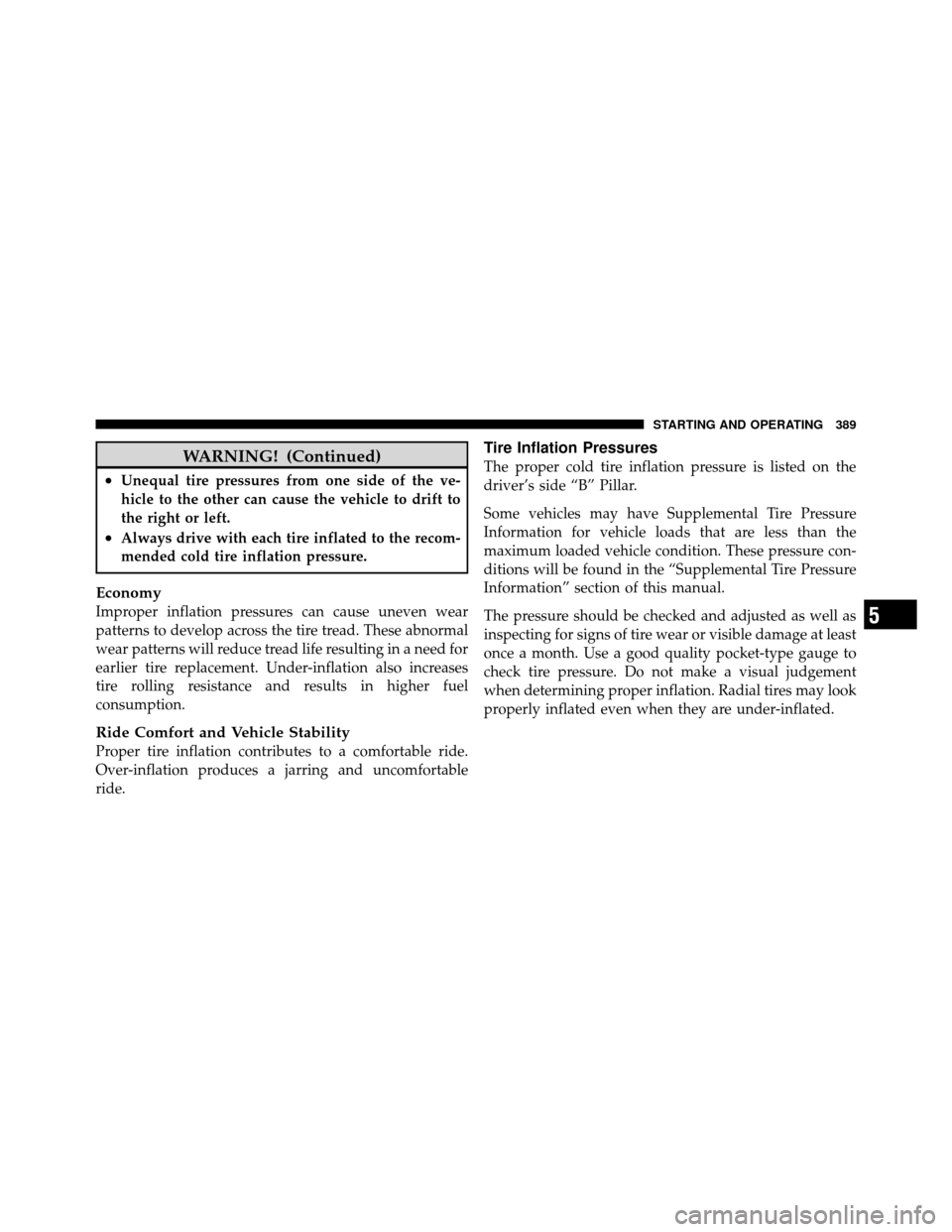
WARNING! (Continued)
•Unequal tire pressures from one side of the ve-
hicle to the other can cause the vehicle to drift to
the right or left.
•Always drive with each tire inflated to the recom-
mended cold tire inflation pressure.
Economy
Improper inflation pressures can cause uneven wear
patterns to develop across the tire tread. These abnormal
wear patterns will reduce tread life resulting in a need for
earlier tire replacement. Under-inflation also increases
tire rolling resistance and results in higher fuel
consumption.
Ride Comfort and Vehicle Stability
Proper tire inflation contributes to a comfortable ride.
Over-inflation produces a jarring and uncomfortable
ride.
Tire Inflation Pressures
The proper cold tire inflation pressure is listed on the
driver’s side “B” Pillar.
Some vehicles may have Supplemental Tire Pressure
Information for vehicle loads that are less than the
maximum loaded vehicle condition. These pressure con-
ditions will be found in the “Supplemental Tire Pressure
Information” section of this manual.
The pressure should be checked and adjusted as well as
inspecting for signs of tire wear or visible damage at least
once a month. Use a good quality pocket-type gauge to
check tire pressure. Do not make a visual judgement
when determining proper inflation. Radial tires may look
properly inflated even when they are under-inflated.
5
STARTING AND OPERATING 389
Page 404 of 566

CAUTION!
•The TPMS has been optimized for the original
equipment tires and wheels. TPMS pressures and
warning have been established for the tire size
equipped on your vehicle. Undesirable system
operation or sensor damage may result when us-
ing replacement equipment that is not of the same
size, type, and/or style. Aftermarket wheels can
cause sensor damage. Do not use aftermarket tire
sealants or balance beads if your vehicle is
equipped with a TPMS, as damage to the sensors
may result.
•After inspecting or adjusting the tire pressure,
always reinstall the valve stem cap. This will
prevent moisture and dirt from entering the valve
stem, which could damage the TPM sensor.NOTE:
•The TPMS is not intended to replace normal tire care
and maintenance or to provide warning of a tire failure
or condition.
•The TPMS should not be used as a tire pressure gauge
while adjusting your tire pressure.
•Driving on a significantly under-inflated tire causes
the tire to overheat and can lead to tire failure.
Under-inflation also reduces fuel efficiency and tire
tread life, and may affect the vehicle’s handling and
stopping ability.
•The TPMS is not a substitute for proper tire mainte-
nance, and it is the driver ’s responsibility to maintain
correct tire pressure using an accurate tire pressure
gauge, even if under-inflation has not reached the
level to trigger illumination of the TPM Telltale Light.
402 STARTING AND OPERATING